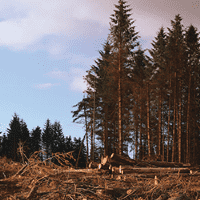So how has forestry performed? Based on our market research, cash on deposit would have accumulated 19% in value before tax over the period since the financial crisis, however, a spruce tree growing on a hill in South Scotland would have accumulated 36% in value tax free over the same time, simply as a result in the change in size of the tree. Excellent performance in its own right, but factor in inflationary growth in capital market value and the performance is boosted to over 80%.
At the date of writing, the best savings interest rate to be found on moneysupermarket.com was 2.51% for a five-year fixed-rate bond from a challenger bank. The questions in my mind are therefore, at around 8% per annum, why not trees and, how long can this performance continue?
Looking at the market in 2017, although the area of forest traded was down slightly on 2016 it was near to the medium term average, therefore there was product available for would-be investors.
However, despite the small drop in area traded, the overall value of the market rose by nearly a quarter demonstrating another strong rise in underlying average capital values. Based on the key principles of property investment, strong increases in capital value must feed through to downward pressure on the returns achievable, whether actual or claimed.
Demand is, of course, not constant across all woodland types and is strongest for productive timber forests with late rotation spruce plantations exhibiting some exceptionally competitive sales during the year. A requirement to secure wood fibre appears to be the dominant driver and as we have reported for several years, the obvious taxation benefits of owning commercial woodland have slid in importance.
Positive news stories
As in previous years, woodland with mixed conifer species or any property with land or access constraints has been slower to sell unless keenly priced. Demand for amenity and small woodlands appears to be strengthening again driven by returning consumer confidence and wider understanding of the benefits of woodland ownership.
Timber prices have posted strong growth during the 2017 forest year (1st October 2016 to 30th September 2017), benefiting from both weaker sterling and strong demand for roundwood from domestic mills. Demand for small roundwood is pushing from the bottom which has set a floor price, due to increasing domestic demand from sluggish imports and a cold winter.
New planting continues to provide positive news stories with application levels in Scotland beginning to approach government targets, but other areas of the UK continue to exhibit slow progress, despite plenty of seemingly positive encouragement.
We consider land value as a key constraint and there is a pinch point where forestry cannot compete. Our research shows that the average land value in England is just under £8,000 per acre, or £5,000 per acre for poor livestock land. However, in Scotland, where a lot more planting takes place, suitable land is generally below £2,000 per acre, meaning the case for conversion to productive forest is easily made.
Forest investment analysis
Methodology: Our research analyses our transactional database of forest sales. This database collates data from all mainstream forestry transactions, and where we are aware, off-market or private sales.
While every effort is taken to ensure all transactions are included within the information presented within this publication, it is very likely that further sales are known about following the launch of publications. Therefore, historic data previously reported within our 'Spotlight On The UK Forestry Market' 2015, 2016 and 2017 has been updated to take account of new available information within the marketplace.


.png)
.png)
.png)
